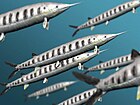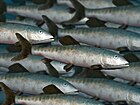Pholidophorus
| Pholidophorus Temporal range:
| |
|---|---|
| Scientific classification | |
| Kingdom: | Animalia |
| Phylum: | Chordata |
| Class: | Actinopterygii |
| Order: | † |
| Family: | †Pholidophoridae |
| Genus: | †Pholidophorus Agassiz, 1832 |
| Species: | †P. latiusculus
|
| Binomial name | |
| †Pholidophorus latiusculus Agassiz, 1832
| |
Pholidophorus (from Greek: φολῐ́ς pholis, 'horny scale' and Greek: φέρω phérō, 'to bear')[1] is an extinct genus of stem-teleost fish. Numerous species were assigned to this genus in the past, but only the type species Pholidophorus latiusculus, from the Late Triassic of Europe, is considered to be a valid member of the genus today.[2][3]
Taxonomy[]
The genus Pholidophorus for a long time served as a wastebasket taxon containing various unrelated species of basal stem-teleosts. Over the years, many of these have been moved to separate genera. The Late Jurassic nominal species "Pholidophorus" purbeckensis was renamed Ichthyokentema by Arthur Woodward in 1941.[4] Likewise, the Early Jurassic form "Pholidophorus" bechei was renamed Dorsetichthys and moved to its own family, Dorsetichthyidae, by Arratia (2013).[5] The nominal species "Pholidophorus" friedeni Delsate, 1999 and "Pholidophorus" gervasuttii Zambelli, 1980 were renamed and by Taverne and Steurbaut (2017) and Arratia (2017) respectively.[6][2]
Description[]
Pholidophorus was a herring-like fish about 40 centimetres (16 in) long, although it was not closely related to modern herring. Like them, however, it had a single dorsal fin, a symmetrical tail, and an anal fin placed towards the rear of the body. It had large eyes and was probably a fast-swimming predator, hunting planktonic crustaceans and smaller fish.[7]
A very early teleost, Pholidophorus had many primitive characteristics such as ganoid scales and a spine that was partially composed of cartilage, rather than bone.[7]
References[]
- ^ Roberts, G. (1839). An etymological and explanatory dictionary of the terms and language of geology. London: Longman, Orme, Brown, Green, & Longmans. p. 133. Retrieved 31 December 2021.
- ^ a b Arratia, G. (2017). "New Triassic teleosts (Actinopterygii, Teleosteomorpha) from northern Italy and their phylogenetic relationships among the most basal teleosts". Journal of Vertebrate Paleontology. 37 (2): e1312690. doi:10.1080/02724634.2017.1312690. S2CID 89773927.
- ^ Taverne, L. (2018). "The Mesozoic fish genus Pholidophorus (Teleostei, Pholidophoriformes), with an osteological study of the type-species Pholidophorus latiusculus. Comments on some problems concerning the "pholidophoriform" fishes" (PDF). Geo-Eco-Trop. 42 (1): 89–116.
- ^ Griffith, J.; Patterson, C. (1963). "The structure and relationships of the Jurassic fish Ichthyokentema purbeckensis". Bulletin of the British Museum (Natural History), Geology. 8 (1): 1–43. doi:10.5962/p.313875.
- ^ Arratia, G. (2013). "Morphology, taxonomy, and phylogeny of Triassic pholidophorid fishes (Actinopterygii, Teleostei)". Journal of Vertebrate Paleontology. 33 (sup1): 1–138. doi:10.1080/02724634.2013.835642. S2CID 86605978.
- ^ Taverne, L.; Steurbaut, E. (2017). "Osteology and relationships of Luxembourgichthys ("Pholidophorus") friedeni gen. nov. (Teleostei, "Pholidophoriformes") from the Lower Jurassic of Belgium and the Grand Duchy of Luxembourg". Geologica Belgica. 20 (1–2): 53–67. doi:10.20341/gb.2017.003.
- ^ a b Palmer, D., ed. (1999). The Marshall Illustrated Encyclopedia of Dinosaurs and Prehistoric Animals. London: Marshall Editions. pp. 38–39. ISBN 1-84028-152-9.
- Pholidophoridae
- Monotypic ray-finned fish genera
- Prehistoric ray-finned fish genera
- Norian genera
- Triassic bony fish
- Late Triassic fish of Europe
- Fossil taxa described in 1832
- Taxa named by Louis Agassiz
- Prehistoric ray-finned fish stubs
- Triassic fish stubs






